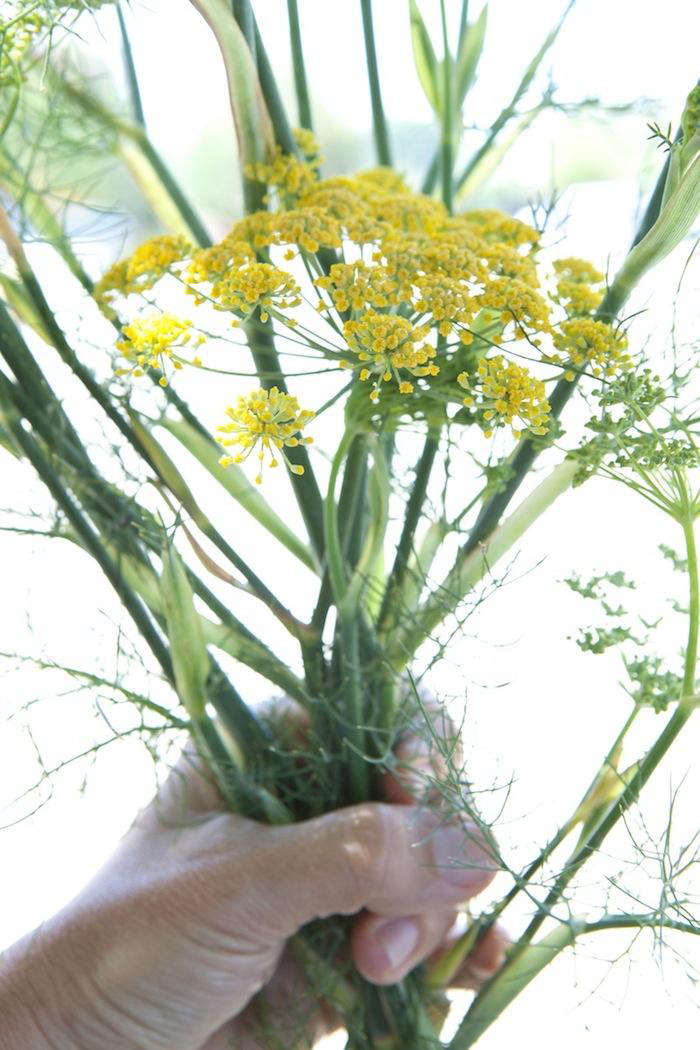Fennel, Foeniculum vulgare
Fennel is such an easy-to-grow herb that it’s considered a roadside weed in California. In cooler climates, perennial Foeniculum vulgare can be grown as an annual. And all parts of the plant, from bulb to fronds to seeds, are edible.
Keep in mind that fennel is not a demure herb to grow in a small container. This behemoth (at maturity, fennel can reach a towering height of 8 feet) requires more attention and space than a pot of parsley on a windowsill. But if you have a sunny spot outdoors with well-drained soil, growing fennel is worth the effort.
Read on to learn more about this Mediterranean herb with a distinctive anise-like flavor:

Native to Mediterranean climates, two main varieties of fennel exist. Foeniculum vulgare is harvested for its flavorful ferny fronds and Foeniculum vulgare var. azoricum (also known as Florence fennel or finocchio) is prized for its edible bulb and is easily grown as a cool season vegetable in the spring or fall.

Both fennel types are quick to flower and produce edible seeds and leaves that can be added to salads or other dishes (the seeds make delicious pickling spices). The seeds also make a medicinal digestive tea: simmer 1 teaspoon of the seeds in one cup of water for five minutes. Remove from the heat, let stand, covered, for 20 minutes before straining.

Fennel has a long history in literature. Legend has it that the wisdom of the Greek gods was brought to them by Mercury, the messenger, in the form of a burning coal in a fennel stick.

In the garden, pollinators rejoice at the site of blooming fennel; green and yellow striped swallowtail caterpillars rank it high on their dietary wishlist.

Fennel in California is labeled an invasive plant, overtaking natural areas and dominating native species. (Fennel can become a complete nuisance if the seeds are given permission to scatter freely.) Do a little research in your area to see if this plant is still a friend or is a foe.
Cheat Sheet
- Cheery yellow umbrella-shaped flower heads are highly attractive to beneficial insects and pollinators including native bees, ladybugs, lacewings, and butterflies.
- Bronze fennel is the preferred host plant for anise swallowtail and the eastern black swallowtail butterflies, so consider adding some to a habitat, tea, or pollinator garden.
- Planting fennel near your roses may keep aphids at bay.
- Herb fennel grows as high as 8 feet; plant it in the back of a vegetable or herb bed.

Keep It Alive
- Plant fennel seeds or starts in full sun to produce the best growth.
- All types benefit from being planted in rich, well-draining soil.
- Despite its Mediterranean origin, bulb fennel dislikes dry conditions. Tip: Dry soil encourages plants to bolt (prematurely flower) at the expense of crisp, juicy bulbs.
- Fennel survives light frosts in USDA zones 6 to 10 and in zones 2 to 5 it grows as an annual.
- Harvest bulb types when they become like small tennis balls. If left to grow larger, the plants may bolt and the bulb flavor will turn bitter.
- Cut back fennel in the winter to prepare for fresh spring growth.
- Few pests trouble seedlings except slugs. Nightly patrols to collect these slimy perpetrators is advised.
- Crowding reduces bulb size, so plant bulb fennel at least 12 inches apart for spring crops and 16 inches for fall crops as they tend to grow larger.
See more growing tips in Fennel: A Field Guide to Planting, Care & Design in our curated guides to Edible Plants 101. Read more:
- DIY: Fennel Seed Harvesting
- Garden-to-Table: Fennel Recipes from 66 Square Feet
- Garden Visit: Sarah Raven’s Perch Hill









Have a Question or Comment About This Post?
Join the conversation